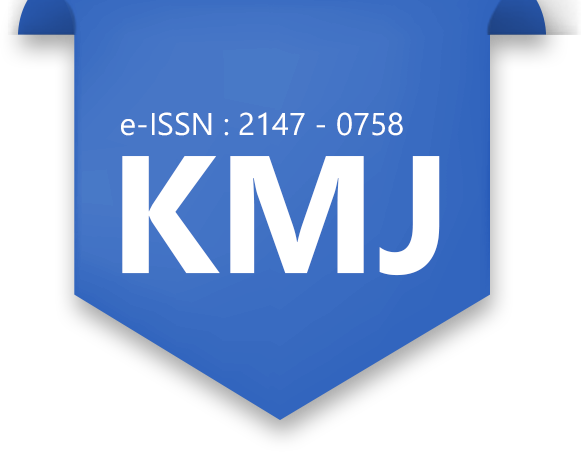
The Effect of Body Mass İndex to Functional Results After Arthroscopic Rotator Cuff Repair
Sinan Oguzkaya1, Turan Bilge Kizkapan21Sarkisla State Hospital, Departments Of Orthopedics And Traumatology, Sivas, Turkey2Cekirge State Hospital, Department Of Orthopedics And Traumatology, Bursa, Turkey
INTRODUCTION: Rotator cuff tear is a common cause of shoulder pain and dysfunction. Many factors, including age, comorbidities, pre-operative muscle atrophy, and fatty degeneration, may affect functional outcomes after rotator cuff repair (RCR). The purpose of the study was to evaluate the effect of obesity on functional outcomes and complication rates after arthroscopic RCR.
METHODS: A total of 154 patients who underwent arthroscopic RCR between 2017 and 2019 were included in the study. Patients divided into two groups as non-obese (Group 1 [n=118], 76.6%, 56 females, 62 males) and obese (Group 2 [n=36], 23.4%, 25 females, 11 males). Constant-Murley Score (CS), American Shoulder and Elbow Surgeons score (ASES), Visual analogue scale (VAS) score, and Short-Form 36 (SF-36) quality of life scale were used in the measurement of outcomes. Length of surgery, hospital stay, and complications were compared between the two groups (P=0.000).
RESULTS: Both pre-operative and postoperative CS, ASES, and SF-36 scores were significantly lower in the obese group (P=0.000). Also, the VAS score was higher in Group 2. The re-tear rate was significantly higher in obese group (27% vs. 4.2%, P=0.000). The duration of the surgery and hospital stay were significantly higher in the obese.
DISCUSSION AND CONCLUSION: Obese group have worse pre-operative and postoperative functional outcome scores and life quality measures when compared to non-obese patients. Also, re-tear rates are higher in obese patients.
Vücut Kitle İndeksinin Artroskopik Rotator Kılıf Cerrahisi Sonrası Fonksiyonel Sonuçlara Etkisi
Sinan Oguzkaya1, Turan Bilge Kizkapan21Şarkışla Devlet Hastanesi, Ortopedi Ve Travmatoloji Bölümü, Sivas, Türkiye2Çekirge Devlet Hastanesi, Ortopedi Ve Travmatoloji Bölümü, Bursa, Türkiye
GİRİŞ ve AMAÇ: Rotator kılıf yırtığı omuz ağrısı ve kısıtlılığının sık görülen bir sebebidir. Yaş, ek hastalıklar, preoperatif kas atrofisi ve yağlı dejenerasyon gibi bir çok faktör rotator kılıf tamiri sonuçlarını etkileyebilmektedir. Çalışmanın amacı obezitenin artroskopik rotator kılıf tamiri yapılan hastalarda fonksiyonel sonuçlara ve komplikasyon sıklığına etkisini incelemektir.
YÖNTEM ve GEREÇLER: 217-2019 yılları arasında artroskopik rotator kılıf tamiri yapılan 154 hasta çalışmaya dahil edildi. Hastalar obez olmayan (Grup 1 [n=118], 76.6%, 56 kadın, 62 erkek) ve obez olan olarak iki gruba ayrıldı (Grup 2 [n=36], 23.4%, 25 kadın, 11 erkek). Sonuçları ölçmek için Constant Murley Skoru (CS), American Shoulder and Elbow Surgeons (ASES) skoru, Visual analogue scale (VAS) skoru ve Short-Form 36 (SF-36) skoru kullanıldı. Cerrahi süresi, hastane yatış süresi ve komplikasyon sıklıkları her iki grup arasında karşılaştırıldı.
BULGULAR: Preoperatif ve postoperatif CS, ASES, SF-36 skorları obez grupta daha düşüktü ayrıca VAS skoru obez grupta anlamlı olarak daha yüksekti(P=0.000). Rerüptür oranı obez grupta daha yüksekti (27% vs. 4.2%, P=0.000). Cerrahi süre ve hastane yatışı obez grupta daha yüksekti (P=0.000).
TARTIŞMA ve SONUÇ: Obez gruptaki hastaların preoperatif ve postoperatif fonskiyonal sonuçları ve hayat kalitesi skorları obez olmayan hastalara göre anlamlı olarak düşük olarak görülmüştür. Ayrıca reruptur oranları obez grupta daha yüksektir.
Manuscript Language: English












